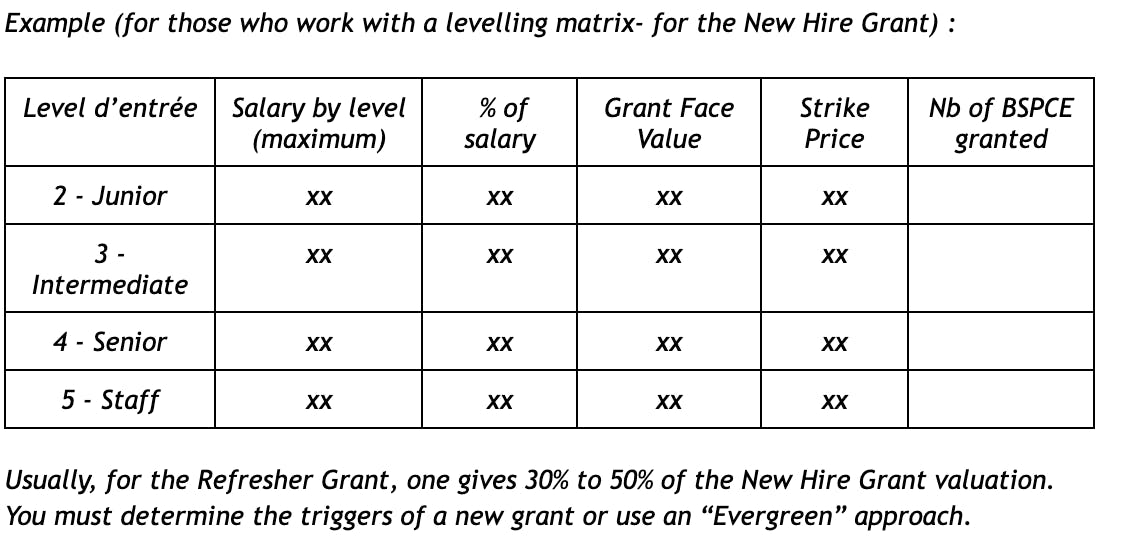In practice : How to set up your BSPCE policy in a startup
Many HR leads have found themselves in my situation, especially when joining the startup/scale-up ecosystem.
That moment when you have to create a policy from scratch while also gaining skills on the subject (the generalist principle being that you’re not a specialist in every topic!) and not knowing where to start.
I had to delve into the BSPCE topic at Qovery, and here’s what my journey looked like to lay the groundwork for a simple policy that aligns with our company's values and stage of maturity.
Folks, let’s go back to basics regarding BSPCE and start with a reminder:

Marie Mallassi
April 22, 2024 · 7 min read
#What is the “BSPCE”?
BSPCE means “Bon de Souscription de Parts de Créateurs d’Entreprise”. It is an intuitu personae legal instrument allowing the company’s employees (or corporate officers) to take an interest in its future results within a favourable tax framework.
BSPCEs make it possible to allow employees to acquire, in the long term, a share of the company subject to (i) being an employee of the company for a certain period or (ii) achieving specific objectives defined upstream.
Legally, it is an option that gives its beneficiary, under certain conditions, the right to subscribe to a share of the issuing company at a price pre-defined when it is granted: the strike price.
#Before starting, a bit of glossary…
Working on this topic, you’ll probably notice a particular lexical field:
BSPCE: a French term meaning “Bons de Souscription de Parts de Créateurs d’Entreprise”. It allows you to buy shares at a price determined in advance and whose value will increase (potentially) if the company grows.
Grand date: BSPCE attribution date (at the earliest, your team member's hiring date).
Exercise: converting their BSPCE into company shares by paying the exercise price.
Strike or exercise price: the price the team member must pay to convert the BSPCE (acquired) into company shares. This price is fixed at the time of the granting.
Vesting calendar: acquisition calendar, waiting period before exercising your BSPCE by paying the strike price. From what I’ve seen, most vesting calendars are for four years, with a one-year cliff period.
#How does it work?
Let’s take a concrete example!
When the company’s share increases, the team member can resell their share at the price they bought it for (the initial value).
Example: Your team member receives 100 shares worth 15€. If the share price goes to 30€, the employee can receive the added value by reselling their shares. So 3000-1500= 1500€.
If the share price does not increase, the team member does not make any profit, and it is not interesting for them to resell it.
#Establishing a policy convenient to Qovery: the “WHY” behind.
Be realistic when talking about the market: We are in a very dynamic ecosystem of startups and burgeoning businesses. Attracting and retaining top talent for sustainable growth and success is key. As an HR Lead, this was at the top of my mind.
In this context, the BSPCE policy may be a tool companies in France often use to reward employees. I said “may” because, culturally speaking, we don’t have the same approach regarding shares in France as in the US or UK. I see many candidates who are not so sensitive to BSPCE when presenting the offers, while there are many benefits for them.
It was evident that we wanted to propose BSPCE to our team members at Qovery, mainly for the three reasons below:
- To attract top talent: as said above, the BSPCEs are a powerful tool for attracting skilled professionals who are motivated by the potential to share in the company’s success. All the people who recruit in the tech ecosystem know how hard it can be to stay competitive!
- Retain Top Talents: We do think that our team is an “A players” team 🤗. By offering BSPCEs, we can incentivise team members to remain committed to the company’s long-term objectives as the value increases with the company’s growth.
- Alignment of interests: BSPCEs align the interests of team members with those of the company’s shareholders, fostering a sense of ownership and commitment among team members.
#My way of thinking to set up the policy:
First, I decided to manage this topic as I’d manage a new project, meaning defining my deliverables at the end of my work.
- A clear policy about BSPCE granting
- A communication doc to inform eligible employees
- A realistic projection table on how your BSPCE pool should be constituted
Then, you should identify the stakeholders on this topic. On my side, I have identified key people to contribute. Obviously, Qovery’s founders. Thus, I have also relied on our lawyers to understand the legal framework and the documentation. We work with the BOLD agency, and we are pretty satisfied with them so far.
As I needed to increase my skills in this area, I did a lot of research and HR watch. Many companies share some information about the BSPCE system (e.g. Figures). You can also read the excellent “The Galion Project” or this blog.
Last but not least, I have relied on expert people on my network who have agreed to help me and review my work—a huge thank you to them. If you feel uncomfortable, don’t be scared to ask for help (LinkedIn is also made for that 😉), as it is a specific and sensitive topic.
After clarifying our “WHY,” I worked on defining our guiding principles based on Qovery's core values, this is the pillar of every HR project, but it is the most challenging part. The purpose was to set up a new policy and define one that IS Qovery, perfectly fits who we are and what experience we want our team members to have during their journey within the company.
Example: At Qovery, we strongly value fairness. We have decided to embody this value by defining that everyone at Qovery will be eligible to receive BSPCE, regardless of their level (excluding internships or temporary contracts).
Again, still around fairness: The granting date is the hiring date for everyone.
You got it.
I then defined all our guiding principles following this mindset (how to unlock BSPCE, our vesting agenda, how many shares to attribute depending on the level and the compensation aspects, leaver's conditions …, etc.). I also defined what we want for a “New hire grant” that answers the goal of “attracting top talents,” and I also defined what we want for our “refresher grants” that respond to the goal of “retaining our top talents.”
#What after?
You define all the practical actions you must take based on your guiding principles. I decided to work with percentages, so I prepared clear tables to project what the system could be concrete—one for the New Hire Grant and the other for the refresher grant.
Regarding the refresher grant, it is again a cultural question: do you want a collective mode (probably more suitable for startups) or a more discriminatory one (relevant for more mature companies)?
Indeed, it is fair to say that you want to treat people the same way, but is that possible? You need to consider your dilution impact and your BSPCE burn rate. It might be more relevant to grant people you want to keep.

#How to get a clear vision of your BSPCE pool?
Keep it simple.
- You need to gather information on your current pool (reading the legal documents), such as the validity date, how many BSPCEs have been granted, and how many remain…
- Couple with the hiring projections during the pool validity to confirm that your burn rate is appropriate.
- Keep in mind the probable attrition during the same period.
#The last step is to communicate with the team!
Once your policy is ready and approved by your stakeholders, you must communicate with the team.
At Qovery, we believe in transparency, and it is a no-brainer for us to organise an all-hands meeting on that topic in addition to a well-prepared Notion page.
Review and evaluate your BSPCE policy regularly to assess its effectiveness in achieving its intended objectives.
At Qovery, we know the benefits of a good “test and learn” approach. We always say that our projects are incremental and that we’d need several iterations to reach a suitable model.
So there you have it - the wacky, wonderful world of BSPCEs. Setting up your BSPCE policy can be a strategic move if you want to attract and retain top talent while aligning your team’s interests with the company’s long-term growth objectives.
By understanding the legal framework, following a structured implementation process, and considering the above key factors, you can create a BSPCE policy that powerfully incentivises your team to contribute to the company’s success.
If you’d like to know more or discuss, let’s chat!
Your Favorite DevOps Automation Platform
Qovery is a DevOps Automation Platform Helping 200+ Organizations To Ship Faster and Eliminate DevOps Hiring Needs
Try it out now!

Your Favorite DevOps Automation Platform
Qovery is a DevOps Automation Platform Helping 200+ Organizations To Ship Faster and Eliminate DevOps Hiring Needs
Try it out now!
